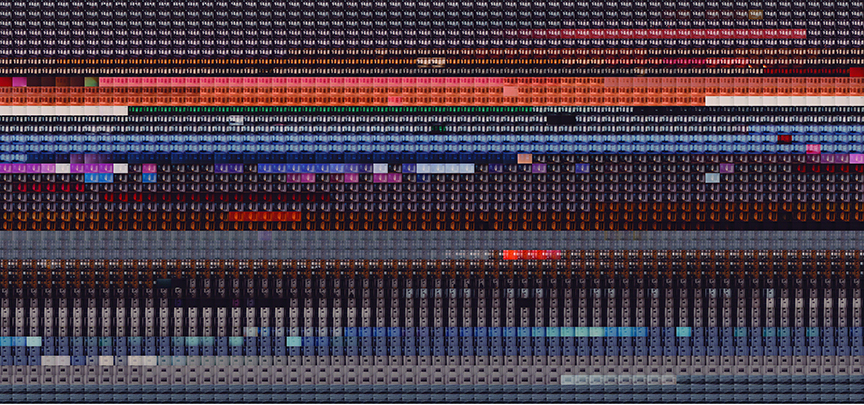In the digital era, a moving image artwork can easily be transformed into a large database of sequentially ordered images. By viewing an artwork as large database of ordered photographic images, it is possible for the viewer to engage with the original work in entirely different ways, in essence, it opens up the artwork to new forms of manipulation and visual analysis.
Wavelength Without the Time (2012) is an image created by reducing Michael Snow’s 45-minute seminal film Wavelength (1967) to a large database of sequentially ordered images. The work is transformed from a cinematic representation of the world (and the single image contained within), to a photographic representation of the film. In an attempt to make Wavelength more accessible the modern viewer, one who constantly craves media stimulation, Snow created WVLNT (or Wavelength For Those Who Don’t Have the Time) (2003) a condensed version of the original. I have attempted to bring Wavelength into the post-cinematic era by further condensing the film, that is, by transforming the film into a single image, removing cinematic time entirely from the equation by transforming time into space.
The original film is a sequence of images revealed (and hidden) over time, a systematic form of photographic peek-a-boo, while Wavelength Without the Time attempts to reveal the entire film at once. Taking a globalized view of the film exposes various aspects of the original film and its production. For instance, it is possible to see the overall colour palette Snow used in its production (through the use of coloured gels, colour inversion and aperture changes). It is also possible to see Snow’s improvisational approach to the work. Although the film is structured around the zoom, Snow plays and improves with all of the other aspects of the cinematic apparatus, similar to the ways in which one makes improvised music.
Using an entirely different approach, Mike’s No [Interior/Exterior] (2015) are rough sketches that attempt to recreate the spaces in which Snow shot <—> (1969). The work is a panorama created by meticulously stitching together individual frames from the film that were obtained from a digitized VHS bootleg of the work. What was once a time-based, experimental film is now a landscape that does not exist in its entirety at any time in the film itself.
Mike’s No Interior (Panorama) and Mike’s No Exterior (Panorama)
Expanding on the techniques developed for this project, All My Life (2016) is a digital panorama derived from Bruce Bailie’s 1966 film of the same name. This digitally-constructed panorama reveals a landscape that only occurs through a digital reconstruction of the film, the work exists in an interstitial space somewhere between filmic and photographic image.

While attempting to create this panorama, I accidentally produced a glitchy digital landscape that seemed to sort the original film by colour while maintaining the structure of the fence and power lines. The image produced was much too large to digitally manipulate, however, by animating the glitchy digital landscape on single roll of super 8 I created All My Life (After Bailie) (2016).
[VIDEO: All My Life (After Bailie)]
Clint Ennis<dogmatodisco@gmail.com> is a regular contributor to the Other Cinema exhibition series.



